Right from
the start of The Sun Also Rises and
until the end, Hemingway brims with a hard boiled masculinity. It’s quite
apparent that his writing style is that of a man’s man. Aside from kung fu
flicks and comic books, few stories channel so much raw masculine energy.
Looking at
the way he constructs sentences, without recognizing the deeper meanings, I get
the sense that he's throwing flurries of verbal jabs in the form of short,
concise, to-the-point sentences. His persistent, hard-hitting brevity reveals his
robust masculinity.
Ironically,
Hemingway writes about a guy named Jake who struggles with sexual impotency, and that name also ironically brings to mind one of the most sexually
potent people in the Bible - Jacob. It’s intriguing
that a manly man such as Hemingway would create a main character with a physical inadequacy that was in stark contrast to his dynamic, real life persona. It seems that Jake is a way for Hemingway to
contemplate his own identity. I wonder
if he was trying to redefine gender roles.
I wonder if he was trying to make a statement on the underlying
powerlessness that exists beneath the surface of man’s supposed masculinity.
Even Jake’s
love interest, Brett, exudes masculinity. She bears a manly name, banters in manly
ways, cuts her hair in manly fashion, and also refers to herself as a “chap.” In fact, she comes across as more masculine
than most of the male characters. Jake, along with the rest of the men, deals
with various insecurities and feelings of inferiority while Brett remains
confident and unflappable, basically dominating the others with her flair and promiscuity.
What was Hemingway’s intention and inspiration for such a woman? Was he trying
to describe the emancipated woman of the 1920s? Was he trying to reassess
gender roles? Was he painting a portrait of his ideal woman? Was Brett a
manifestation of latent homosexuality? I
don’t know, but I wonder.


This was a great review and analysis. Despite all our progress, this issue hasn't left.
ReplyDeleteyeah, it's one of those persistent issues.
DeleteI read this some years ago and couldn't really fathom it out.
ReplyDeleteHis book 'A Farewell to Arms' was a better read than it's transition to film.
The only other Hemingway I really enjoyed was 'For Whom The Bell Tolls'
this is the only one of his i've read, so i'll have to check those others out.
DeleteI am also befuddled by what Hemingway was trying to say by creating the characters as he did. It would certainly be interesting to get the true answers to the questions you asked.
ReplyDeleteyes indeed.
DeleteI have to say I've never read him. Jut hasn't grabbed me I suppose. I think you concisely described the book, perhaps I should read it...
ReplyDeleteYou asked about Louis Malle films:
Au Revoir Les Enfants, classic human story
My Dinner with Andre,rises above its physical limitations being a film of a meal.
Lacombe Lucien, about collaborators in WW2 France
Atlantic City, of its time, a study of a city regenerating and Burt Lancaster as an older person gaining new life
Vanya on 42nd St, a film of a performance of Uncle Vanya
The Lovers,early 1960s love story classic new wave film
Lift to the scaffold, has a sound track by Miles Davis
Murmur of the Heart interesting film,
- some of these are the English titles, I've just looked at IMDB to get the names. Happy watching
Awesome! thanks for sharing that list.
DeleteSounds like quite a thought evoking read with many questions. I guess a lot must be left up to the reader's interpretation. I haven't read it myself, but I'll have to add it to my list of books to read. :)
ReplyDeleteyes please add it and lemme know what you think when you do get to it.
Delete